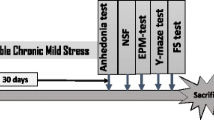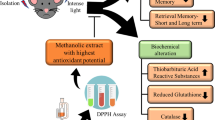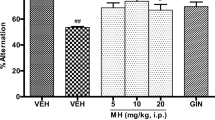Abstract
Alzheimer’s disease (AD), one of the progressive neurodegenerative diseases might be associated with exposure to stress and altered living conditions. This study aimed to evaluate the effectiveness of Ocimum basilicum (OB) essential oils in improving the neurodegenerative-like changes induced in mice after exposed to chronic unpredictable mild stress (CUMS). Forty male Swiss albino mice divided into four groups (n = 10); the control, CUMS, CUMS + Fluoxetine, CUMS + OB were used. Behavioral tests, serum corticosterone level, hippocampus protein level of the glucocorticoid receptors (GRs) and brain-dreived neurotropic factor (BDNF) were determined after exposure to CUMS. Hippocampus was histopathologically examined. Data were analyzed using statistical package for the social sciences (SPSS) and P value of less than 0.05 was considered significant. OB diminished the depression manifestation as well as impaired short term memory observed in the mice after exposure to the CUMS as evidenced by the forced swimming and elevated plus maze test. OB also up-regulated the serum corticosterone level, hippocampal protein level of the glucocorticoid receptor and the brain-derived neurotropic factor and reduced the neurodegenerative and atrophic changes induced in the hippocampus after exposure to CUMS. Essential oils of OB alleviated the memory impairment and hippocampal neurodegenerative changes induced by exposure to the chronic unpredictable stress indicating that it is the time to test its effectiveness on patients suffering from Alzheimer disease.







Similar content being viewed by others
References
Aicardi G (2013) New hope from an old drug: fighting Alzheimer's disease with the cancer drug bexarotene (targretin)? Rejuvenation Res 16(6):524–528. https://doi.org/10.1089/rej.2013.1497
Aleisa AM, Alzoubi KH, Gerges NZ, Alkadhi KA (2006) Chronic psychosocial stress-induced impairment of hippocampal LTP: possible role of BDNF. Neurobiol Dis 22:453–462
Alzheimer’s Association (2015) Alzheimer's disease facts and figures. Alzheimers Dement 11(3):332–384
Ayuob NN, Ali SS, Suliaman M, El Wahab MG, Ahmed SM (2016) The antidepressant effect of musk in an animal model of depression: a histopathological study. Cell Tissue Res 366(2):271–284
Bae D, Seol H, Yoon HG, Na JR, Oh K, Choi CY, Lee DW, Jun W, Youl Lee K, Lee J, Hwang K, Lee YH, Kim S (2012) Inhaled essential oil from Chamaecyparis obtuse ameliorates the impairments of cognitive function induced by injection of β-amyloid in rats. Pharm Biol 50(7):900–910
Bancroft JD, Gamble M (2008) Theory and practice of histological techniques, 6th edn. Churchill Livingstone, Philadelphia
Bora KS, Arora S, Shri R (2011) Role of Ocimum basilicum L. in prevention of ischemia and reperfusion-induced cerebral damage, and motor dysfunctions in mice brain. J Ethnopharmacol 137:1360–1365
Chen W, Mao L, Xing H, Xu L, Fu X, Huang L, Huang D, Pu Z, Li Q (2015) Lycopene attenuates Aβ1-42 secretion and its toxicity in human cell and Caenorhabditis elegans models of Alzheimer disease. Neurosci Lett. https://doi.org/10.1016/j.neulet.2015.10.009
Chioca LR, Ferro MM, Baretta IP, Oliveira SM, Ferreira J, Losso EM, Andreatini R, Silva CR (2013) Anxiolytic-like effect of lavender essential oil inhalation in mice: Participation of serotonergic but not GABA neurotransmission. J Ethnopharmacol 147:412–418
Chung JK, Plitman E, Nakajima S, Chakravarty MM, Caravaggio F, Gerretsen P, Iwata Y, Graff-Guerrero A (2016) Cortical amyloid β Deposition and current depressive symptoms in Alzheimer disease and mild cognitive impairment. J Geriatr Psychiatry Neurol 29(3):149–159
Cvetković-Dožić D, Skender-Gazibara M, Dožić S (2001) Neuropathological hallmarks of Alzheimer's disease. Arch Oncol 9(3):195–199
Doro R, Lotan D, Versano Z, Benatav L, Franko M, Armoza S, Kately N, Rehavi M (2014) Escitalopram or novel herbal mixture treatments duringor following exposure to stress reduce anxiety like behavior through corticosterone and BDNF modifications. PLoS One 9(4):e91455. https://doi.org/10.1371/journal.pone.0091455 eCollection 2014
Doron R, Lotan D, Einat N, Yaffe R, Winer A, Marom I, Meron G, Kately N, Rehavi M (2014) A novel herbal treatment reduces depressive-like behaviors and increases BDNF levels in the brain of stressed mice. Life Sci 94(2):151–157
Duman RS, Monteggia LM (2006) A neurotrophic model for stress-related mood disorders. Biol Psychiatry 59:1116–1127
Dwivedi Y, Rizavi HS, Pandey GN (2006) Antidepressants reverse corticosterone-mediated decrease in brain-derived neurotrophic factor expression: differential regulation of specific exons by antidepressants and corticosterone. Neuroscience 139(3):1017–1029
Gong S, Miao YL, Jiao GZ, Sun MJ, Li H, Lin J, Luo MJ, Tan JH (2015) Dynamics and correlation of serum cortisol and corticosterone under different physiological or stressful conditions in mice. PLoS One 10(2):e0117503
Grayer RJ, Bryan SE, Veitch NC, Goldstone FJ, Paton A, Wollenweber E (1996) External flavones in sweet basil, Ocimum basilicum, and related taxa. Phytochemistry 43(5):1041–1047
Hritcu L, Cioanca O, Hancianu M (2012) Effects of lavender oil inhalation on improving scopolamine-induced spatial memory impairment in laboratory rats. Phytomedicine 19(6):529–534. https://doi.org/10.1016/j.phymed.2012.02.002
Huang Y, Skwarek-Maruszewska A, Horré K, Vandewyer E, Wolfs L, Snellinx A et al (2015) Loss of GPR3 reduces the amyloid plaque burden and improves memory in Alzheimer's disease mouse models. Sci Transl Med 7(309):309ra164
Ismail M (2006) Central Properties and Chemical Composition of Ocimum basilicum Essential Oil. Pharm Biol 44:619–626
Itoh J, Nabeshima T, Kameyama T (1990) Utility of an elevated plus-maze for the evaluation of memory in mice: effects of nootropics, scopolamine and electroconvulsive shock. Psychopharmacology 101(1):27–33
Johansson L, Guo X, Waern M, Ostling S, Gustafson D, Johansson L, Guo X, Waern M, Ostling S, Gustafson D, Bengtsson C et al (2010) Midlife psychological stress and risk of dementia: a 35-year longitudinal population study. Brain 133:2217–2224
Khan IA, Abourashed EA (2010) Leung’s Encyclopedia of Common Natural Ingredients. Wiley, Hoboken, pp 455–465
Kulkarni SK (2007) Hand book of experimental pharmacology, 3rd edn. Vallabh Prakashan, Delhi, pp 36–38
Laroche S, Davis S, Jay TM (2000) Plasticity at hippocampal to prefrontal cortex synapses: dual roles in working memory and consolidation. Hippocampus 10:438–446
Lee KW, Kim JB, Seo JS, Kim TK, Im JY, Baek IS, Kim KS, Lee JK, Han PL (2009) Behavioral stress accelerates plaque pathogenesis in the brain of Tg2576 mice via generation of metabolic oxidative stress. J Neurochem 108:165–175
Li B, Yamamori H, Tatebayashi Y, Shafit-Zagardo B, Tanimukai H, Chen S, Iqbal K, Grundke-Iqbal I (2008) Failure of neuronal maturation in Alzheimer disease dentate gyrus. J Neuropathol Exp Neurol 67(1):78–84
Li M, Fu Q, Li Y, Li S, Xue J, Ma S (2014) Emodin opposes chronic unpredictable mild stress induced depressive-like behavior in mice by upregulating the levels of hippocampal glucocorticoid receptor and brain-derived neurotrophic factor. Fitoterapia 98:1–10
Liu D, Xie K, Yang X, Gu J, Ge L, Wang X, Wang Z (2014) Resveratrol reverses the effects of chronic unpredictable mild stress on behavior, serum corticosterone levels and BDNF expression in rats. Behav Brain Res 264:9–16
Makhlouf NA, El-Beshbishy RA, Abousetta A (2014) Ginkgo modulates noise-induced hippocampal damage in male albino rats: a light and electron microscopic study. Egypt J Hist 37(1):159–174. https://doi.org/10.1097/01.EHX.0000444078.17248.ab
Marksteiner J, Walch T, Bodner T, Gurka P, Donnemiller E (2003) Fluoxetine in Alzheimer's disease with severe obsessive compulsive symptoms and a low density of serotonin transporter sites. Pharmacopsychiatry 36(5):207–209
McEwen BS (2007) Physiology and neurobiology of stress and adaptation: central role of the brain. Physiol Rev 87:873–904
Mineur YS, Belzung C, Crusio WE (2006) Effects of unpredictable chronic mild stress on anxiety and depression-like behavior in mice. Behav Brain Res 175:43–50
Nobakht M, Hoseini SM, Mortazavi P, Sohrabi I, Esmailzade B, Roosh RN, Omidzahir S (2011) Neuropathological Changes in Brain Cortex and Hippocampus in a Rat Model of Alzheimer’s Disease. Iran Biomed J 15:51–58
Okasha EF (2012) Dentate gyrus changes in an Alzheimer-induced model in adult male albino rats and the possible protection by ginger: Histological and immunohistochemical study. Egypt J Hist 35:711–720
de Paula JJ, Diniz BS, Bicalho MA, Albuquerque MR, Nicolato R, de Moraes EN, Romano-Silva MA, Malloy-Diniz LF (2015) Specific cognitive functions and depressive symptoms as predictors of activities of daily living in older adults with heterogeneous cognitive backgrounds. Front Aging Neurosci 7:139
Pavesi E, Canteras NS, Carobrez AP (2011) Acquisition of Pavlovian fear conditioning using β-adrenoceptor activation of the dorsal premammillary nucleus as an unconditioned stimulus to mimic live predator-threat exposure. Neuropsychopharmacology 36:926–939
Paxinos G, Watson C (1998) The Rat Hippocampus in Stereotaxic Coordinates. Academic Press, San Diego
Popp J, Wolfsgruber S, Heuser I, Peters O, Hüll M, Schröder J, Möller HJ, Lewczuk P, Schneider A, Jahn H, Luckhaus C, Perneczky R, Frölich L, Wagner M, Maier W, Wiltfang J, Kornhuber J, Jessen F (2015) Cerebrospinal fluid cortisol and clinical disease progression in MCI and dementia of Alzheimer's type. Neurobiol Aging 36(2):601–607
Saab BJ, Georgiou J, Nath A, Lee FJS, Wang M, Michalon A et al (2009) NCS-1 in the dentate gyrus promotes exploration, synaptic plasticity, and rapid acquisition of spatial memory. Neuron 63:643–656
Satou T, Kasuya H, Maeda K, Koike K (2014) Daily inhalation of α-pinene in mice: effects on behavior and organ accumulation. Phytother Res 28:1284–1287
Sotiropoulos I, Catania C, Pinto LG, Silva R, Pollerberg GE, Takashima A et al (2011) Stress acts cumulatively to precipitate Alzheimer's disease-like tau pathology and cognitive deficits. J Neurosci 31:7840–7847
Srivareerat M, Tran TT, Salim S, Aleisa AM, Alkadhi KA (2011) Chronic nicotine restores normal Aβ levels and prevents short-term memory and E-LTP impairment in Aβ rat model of Alzheimer’s disease. Neurobiol Aging 32:834–844
Tsigos C, Chrousos GP (2002) Hypothalamic-pituitary-adrenal axis neuroendocrine factors and stress. J Psychosom Res 53:865–871
Wang Y, Kan H, Yin Y, Wua W, Hua W, Wang M, Li W, Li W (2014) Protective effects of ginsenoside Rg1 on chronic restraint stress induced learning and memory impairments in male mice. Pharmacology. Biochemistry and Behavior 120:73–81
Wilson RS, Barnes LL, Bennett DA, Li Y, Bienias JL, Mendes de Leon CF et al (2005) Proneness to psychological distress and risk of Alzheimer disease in a biracial community. Neurology 64:380–382
Wingenfeld K, Wolf OT (2014) Stress, memory, and the hippocampus. Front Neurol Neurosci 34:109–120. https://doi.org/10.1159/000356423
World Medical Association Declaration of Helsinki (2013) Ethical Principles for Medical Research Involving Human Subjects. JAMA 310(20):2191–2194
Yoshiyama K, Arita H, Suzuki J (2015) The effect of aroma hand massage therapy for people with dementia. J Altern Complement Med 21(12):759–765
Zahra K, Khan MA, Iqbal F (2015) Oral supplementation of Ocimum basilicum has the potential to improves the locomotory, exploratory, anxiolytic behavior and learning in adult male albino mice. Neurol Sci 36:73–78
Acknowledgements
The authors thank Yousef Abdullatif Jameel, Chair of Prophetic Medical Applications (YAJCPMA), Faculty of Medicine, King Abdulaziz University, Jeddah, Saudi Arabia, for his support to this study.
Author information
Authors and Affiliations
Corresponding author
Ethics declarations
Conflict of interests
The authors declared no potential conflicts of interest with respect to the research, authorship, and/or publication of this article.
Rights and permissions
About this article
Cite this article
Ayuob, N.N., El Wahab, M.G.A., Ali, S.S. et al. Ocimum basilicum improve chronic stress-induced neurodegenerative changes in mice hippocampus. Metab Brain Dis 33, 795–804 (2018). https://doi.org/10.1007/s11011-017-0173-3
Received:
Accepted:
Published:
Issue Date:
DOI: https://doi.org/10.1007/s11011-017-0173-3




